Diego Rivera: The Making of a Fresco
December 8, 2011 marks the 125th birthday of the Mexican Muralist, Diego Rivera (Dec. 8, 1886 – Nov. 24, 1957). Few artists have had as much influence on me as Rivera, an artist I discovered as a pre-teen while thumbing through art books. Of course in the 1960s Rivera, David Alfaro Siqueiros (Dec. 29, 1896 – Jan. 6, 1974) and José Clemente Orozco (Nov, 23, 1883 – Sept. 7, 1949), became icons to the growing Chicano arts movement. By 1968 I had not only read Rivera’s autobiography, My Art, My Life, but I considered myself a partisan of Mexican Muralism and social realism in general – a position I still hold as a working artist.
In September of this year I visited San Francisco and photographed a number of WPA era murals, the photos and histories of which I will be sharing with readers in the coming months. Rivera painted four superlative murals in the San Francisco Bay Area, the first being Allegory of California, painted 1930-1931 and located in the city’s downtown financial district Stock Exchange Building. The second, The Making of a Fresco Showing the Building of a City, was painted from April-June in 1931 at the San Francisco Art Institute.
Still Life and Blossoming Almond Trees was a small mural originally painted at the private residence of the Stern family in the town of Atherton, on the San Francisco Peninsula; the mural is now found in Stern Hall on the University of California, Berkeley campus. Finally, there is the astounding Pan American Unity mural, painted for the Golden Gate International Exposition in 1940 and now located on the campus of the City College of San Francisco. This post concerns Rivera’s Making of a Fresco, and to celebrate the master’s 125th birthday… I am posting some of the photos I took of this remarkable work.
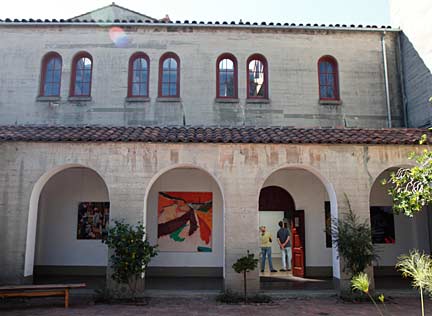
The San Francisco Art Institute (SFAI) is found in the Russian Hill district of the city, fairly close to the famous landmarks of Fisherman’s Wharf and Ghirardelli Square. The institute relocated to its present address on 800 Chestnut St. in 1926, but as an institution it was established in 1871, making it one of the oldest art schools in the United States.
Located in a hilly area that affords practically no parking, the institute is hard to miss because of its Spanish Colonial Revival architecture. Passing through the Baroque arched entrance door to the campus you’ll find an inviting red-tiled courtyard with trees and a charming concrete and tile octagonal fountain. To the fountain’s immediate left you’ll find the “Diego Rivera Gallery“, a beautiful sunlit hall where the mural was painted. The gallery is open daily from 9 am until 5 pm, and the day I visited and photographed the mural, a small crowd was in the gallery. Speaking English, Spanish, and German, the multi-aged pack of visitors was indicative of the art lovers who continue to visit this most remarkable mural.
Rivera’s The Making of a Fresco is a traditional Buon Fresco, painted directly on fresh lime plaster using water-based tempera pigments. One must be accomplished and fast to create this type of mural… the painted on colors are absorbed by the wet plaster, and as the plaster dries the pigments are permanently set.
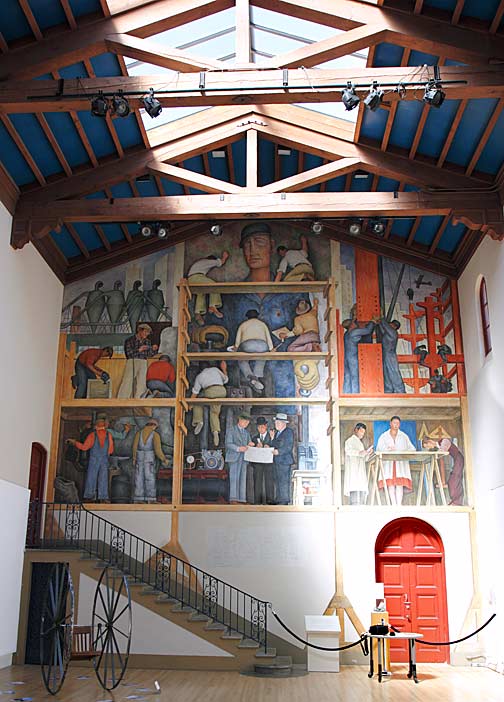
A large mural like The Making of a Fresco is created in sections, with fresh plaster spread over the wall in a given area, a drawing transferred to the wet plaster, and then pigments applied in quick brushstrokes before the plaster dries. Obviously there is little room for mistakes with such a method, and Rivera meticulously worked out his drawings and compositions in exacting detail before beginning such a project. Visually The Making of a Fresco is divided into six sections; while this served a narrative purpose, it also had much to do with the technical aspects of painting such a monumental work.
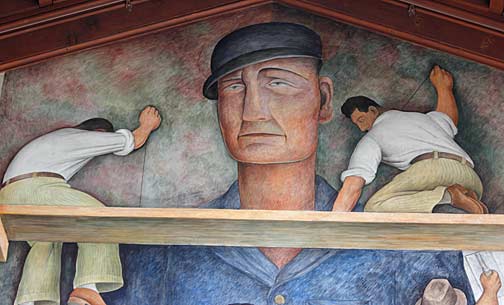
The Making of a Fresco is a trompe l’œil depicting Rivera and assistants on a scaffold painting their fresco mural. While Rivera included a portrait of himself in the work (the central figure with his back to the viewer), the real focus of the fresco is a gigantic worker; an iconic figure representing the entire international working class. In the detail shot above one can see two of Diego’s assistants at work; the artist used painter Viscount John Hastings (left) and sculptor Clifford Wight as models for the mural.
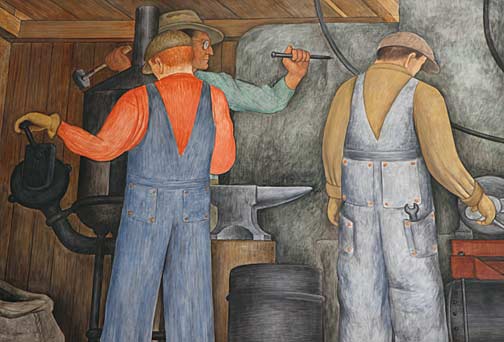
In the above detail the artist painted a worker operating a forge bellows (left), a sculptor hammering a massive block of stone with a chisel (middle), and a belt-machine operator. For Rivera the depiction of workers in his mural was of paramount importance, since from his Marxist perspective the workers produced all wealth and so should be the masters of society.
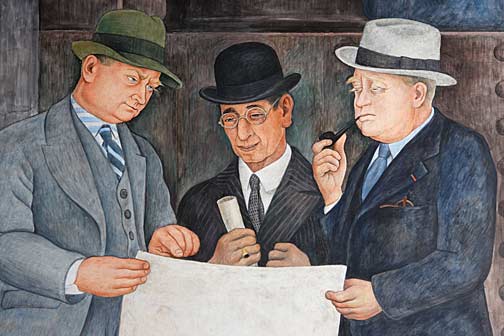
In the above detail taken from the lower center portion of the mural, Rivera portrayed Timothy Pfleuger (left), who was responsible for designing the San Francisco Stock Exchange; William Gerstle (center), a banker, philanthropist, and president of the San Francisco Art Association, and Arthur Brown, the architect who designed Coit Tower, The San Francisco Opera House, and San Francisco City Hall. Again, it must be noted that looming over these three very powerful individuals is the colossal proletarian, Rivera’s not so subtle message that the working class will one day prevail over capitalist elites.

In this detail Rivera painted the portrait of artist Marion Simpson, who was a mosaic artist in Berkeley of some renown (you can see two beautiful mosaics she designed for the Alameda County courthouse here). Rivera painted Ms. Simpson as an architect working in an Architecture and Engineering office, he depicted her standing next to real life architect Michael Baltekal-Goodman (not pictured). For Rivera there was little distinction between those engaged in “manual labor” and those involved in intellectual work; both were exploited by bosses, and in the future both would give their productive energies to the service of humanity rather than profit.

In the above detail of the portrait Rivera created of artist Marion Simpson, one can see the qualities of a traditional fresco. Having an almost marker pen characteristic, one can see how the water-based pigments were soaked up by the plaster. The artist painted with a quick but assured hand, using each brushstroke to indicate form… but in an almost shorthand style.
Viewing Rivera’s frescos up close is a marvelous experience; one is immediately impressed by the textures, brushstrokes, scale, and luminosity lost in photographs. What truly astounded me was seeing Rivera’s preliminary charcoal drawings beneath the layers of paint! While most of the groundwork drawings were covered with vibrant pigment, the artist allowed some of the outlines to show through.
In keeping with the celebration of Rivera’s 125th birthday, I have to mention the currently running exhibition at New York’s MoMA, Diego Rivera: Murals for The Museum of Modern Art. Running from Nov. 13, 2011 to May 14, 2012, the exhibit displays eight portable mural panels the artist painted for his historic retrospective at the museum in 1931.
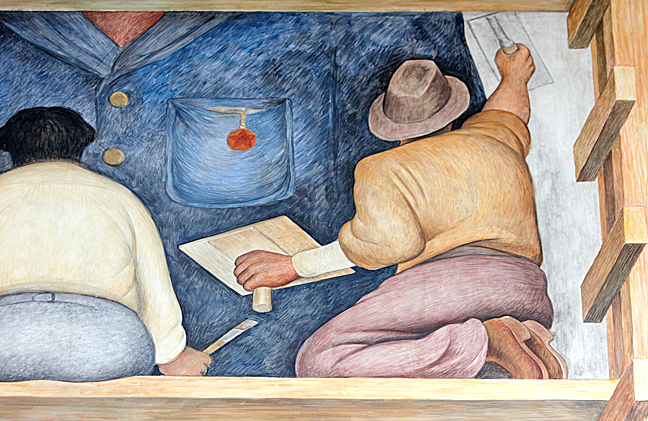

POSTS IN THIS CONTINUING SERIES:
Coit Tower Crisis
Arnautoff & the Chapel at the Presidio
Diego Rivera: Pan American Unity

